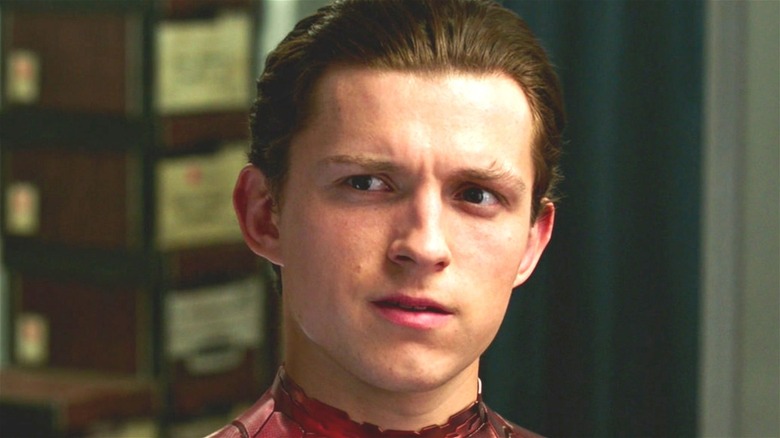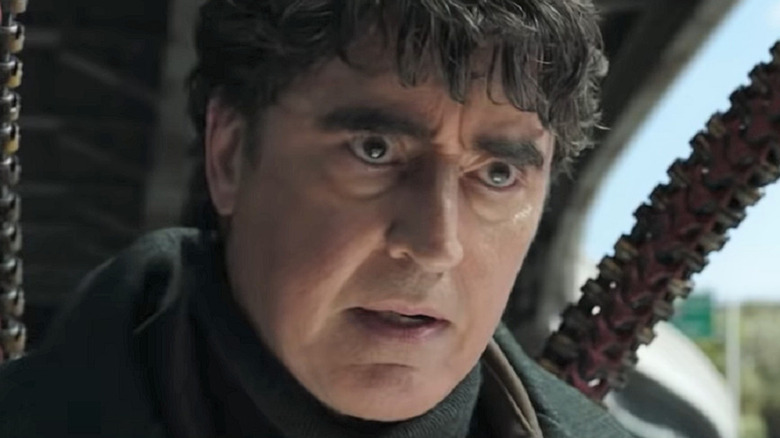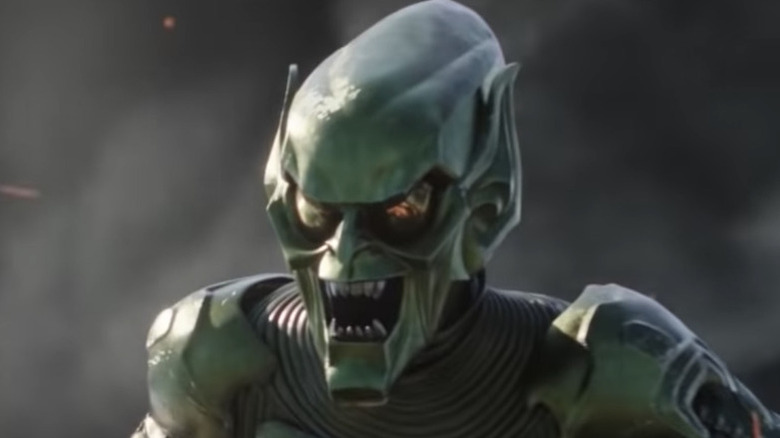Why Didn't Spider-Man: No Way Home Introduce The Sinister Six?
Contains spoilers for "Spider-Man: No Way Home"
"Spider-Man: No Way Home" takes everything you know about Spider-Man films and puts it on a blender, until what emerges is a completely new beginning. Thanks to a botched large-scale identity unlearning spell by Doctor Strange (Benedict Cumberbatch), everyone in the multiverse who's aware of Peter Parker's connection to Spider-Man starts making their way to the MCU Earth. While this means Peter (Tom Holland) gets to meet his alternate universe counterparts Peter (Tobey Maguire) and Peter (Andrew Garfield), it also means that they have to join forces to subdue no less than five of the biggest villains in the history of "Spider-Man" movies: Green Goblin (Willem Dafoe), Doctor Octopus (Alfred Molina), Sandman (Thomas Haden Church), Lizard (Rhys Ifans), and Electro (Jamie Foxx).
The scale of "No Way Home" is downright astounding, and apart from telling a story of its own, it's not afraid to explore deep cuts from the Maguire and Garfield era, either. However, some fans might have wondered why the movie doesn't go all in and include a sixth villain, as well. This would, after all, complete the Sinister Six, a classic super team that consists of villains with a grudge against Spider-Man.
The more you think about the absence of a sixth antagonist, the stranger it is, really. After all, as "No Way Home" proves time and time again, the MCU is very, very good at giving fans what they didn't even know they wanted, and you'd be hard-pressed to find a Spider-fan who wouldn't be over the moon to see the iconic villain team take on the web-slinger — especially in a movie where there's three Spider-Men to even out the odds. So, why didn't Spider-Man: No Way Home introduce the Sinister Six?
The sixth member could be missing for all sorts of reasons
There are many possible reasons why "Spider-Man: No Way Home" doesn't go full Sinister Six. For one, the movie seems to adhere to a pretty strict rule of "one major villain per pre-Tom Holland Spidey movie," and since there's a grand total of five such films, that's pretty much it. Besides, there technically is a sixth villain in the movie, Venom. Only, it's the Tom Hardy incarnation, who only learned of Spider-Man's existence in the post-credits scene of "Venom: Let There Be Carnage." He continues his peripheral MCU existence in the "No Way Home" stinger, which reveals he got stuck getting drunk in a faraway destination, and couldn't be bothered to make his way to New York before he's drawn back to his own reality.
If you refuse to accept Hardy's brief cameo appearance as the missing piece of the Sinister Six, there are several notable movie villains who are missing from "No Way Home" — but there are reasons why they don't show up in the movie. Paul Giamatti had already noted that his Rhino won't appear in "No Way Home," and the Dane DeHaan and James Franco versions of Green Goblin (or, in Franco's case, "New Goblin") would likely have been confusing in a movie that so prominently features the Willem Dafoe version of the character. Likewise, Tom Hardy's Venom pretty much means that the Topher Grace version would've been the odd man out, interesting as it might have been to revisit that incarnation of the character.
This leaves the MCU Spider-Man's own rogues gallery, of which Mysterio (Jake Gyllenhaal) is dead, and Michael Keaton is heavily rumored to reprise his role as Vulture in the upcoming "Morbius," making his appearance here redundant.
No Way Home isn't all that close to being a Sinister Six movie
If you want to get technical about it, "Spider-Man: No Way Home" doesn't really feature even five true supervillains at the same time. Sure, Electro and Lizard are consistently villainous and, at best, biding their time to resume their wicked ways. However, the rest of the film's baddies change their allegiances over the course of the movie. Sandman starts out as something of an ally to Spider-Man, only becoming antagonistic later down the line. Otto Octavius and Norman Osborn are both good dudes when not possessed by their villainous shackles, and it just so happens that the former is freed from the mind control of his AI tentacles around the same time the latter's villainous Goblin persona takes over. Thanks to these various good and evil turns, the group only has the makings of a Sinister Three or Four at any given time.
Further muddying the waters is the fact that the whole plot basically happens because of "Spider-Man: Far from Home" villain Mysterio — whose presence is therefore felt throughout the movie — and J. Jonah Jameson (J.K. Simmons), who reveals Spider-Man's identity to the world, and who most certainly counts as the webslinger's opponent. In fact, even Doctor Strange himself acts as Spideys' antagonist at one point.
As such, you could argue that despite its vast wealth of villainy, "No Way Home" isn't particularly interested in putting Sinister Six together, and simply focuses on telling the best story it possibly can with the antagonists it requires to tell it. Besides, it's always possible that by not giving fans a full iteration of the villain team, "No Way Home" ensures the possibility of a more formal Sinister Six somewhere in poor Peter Parker's future.


